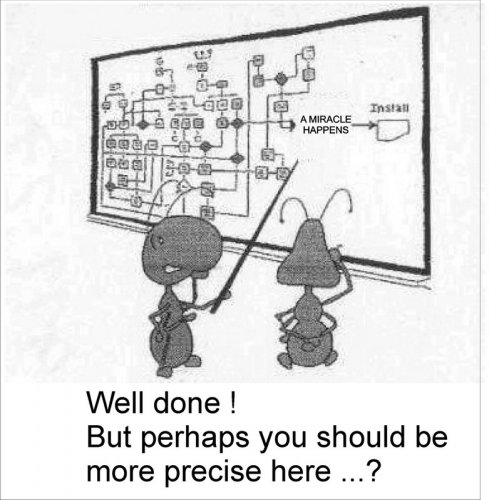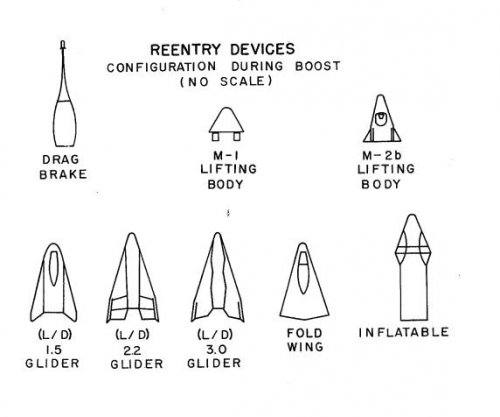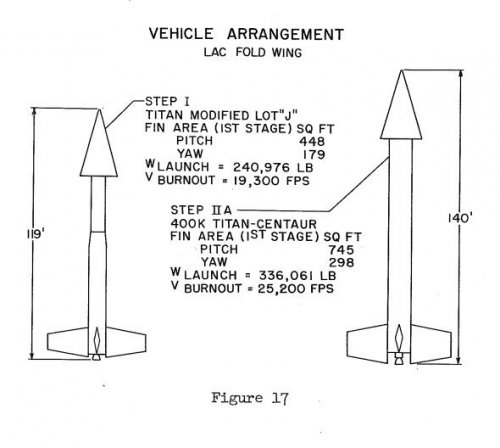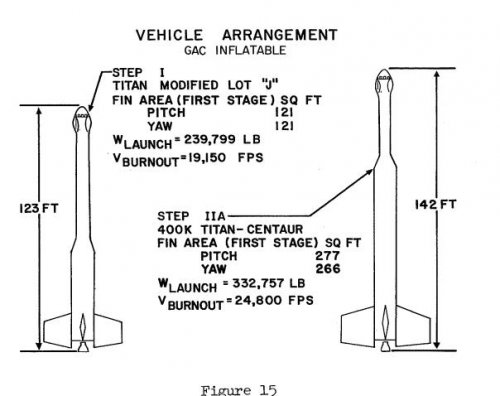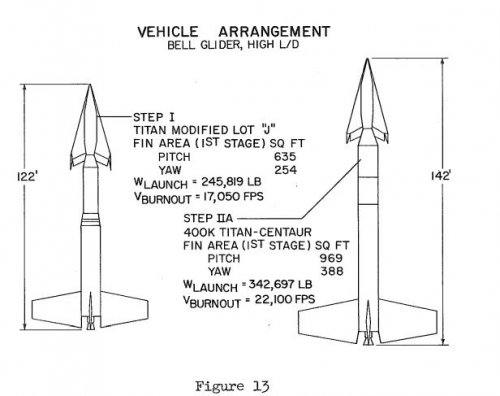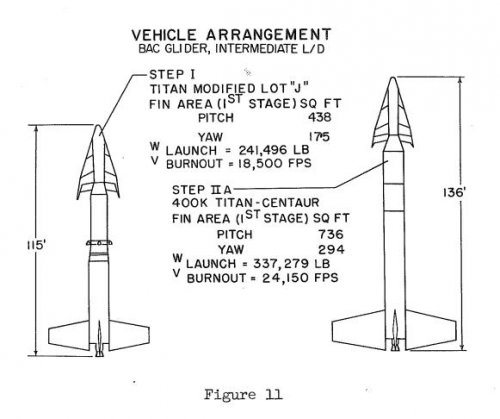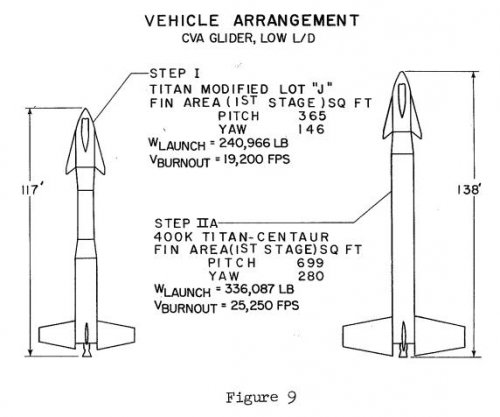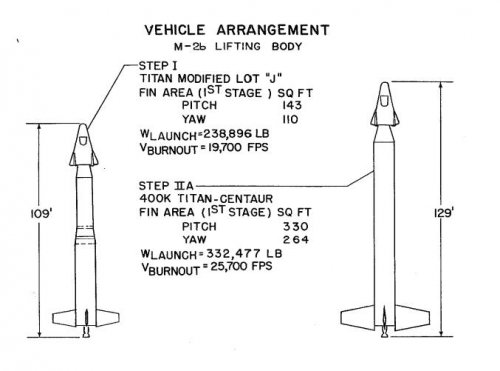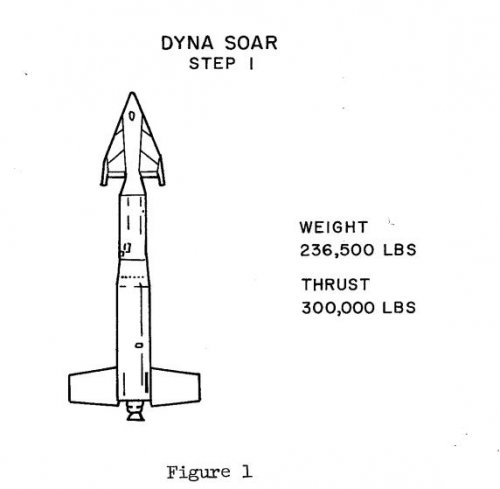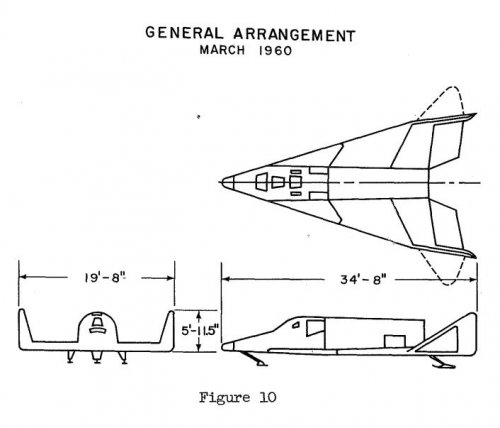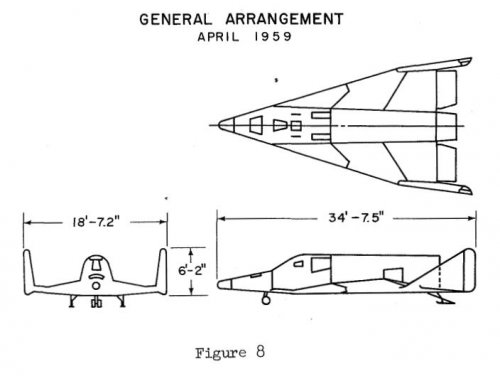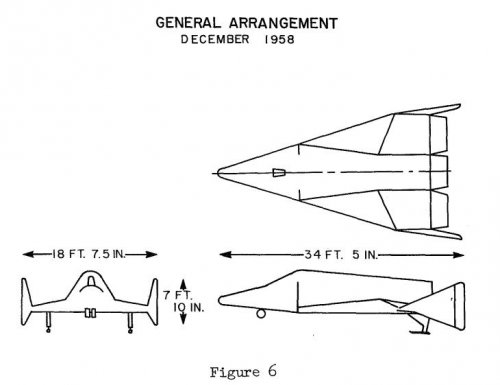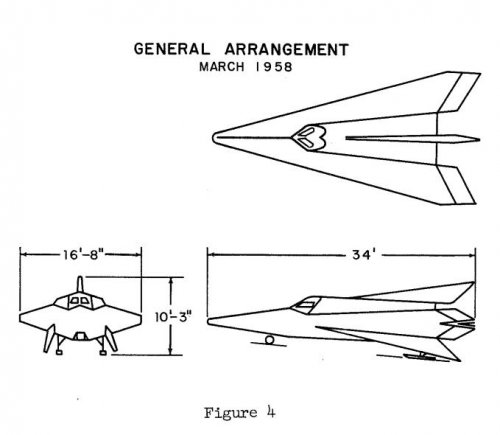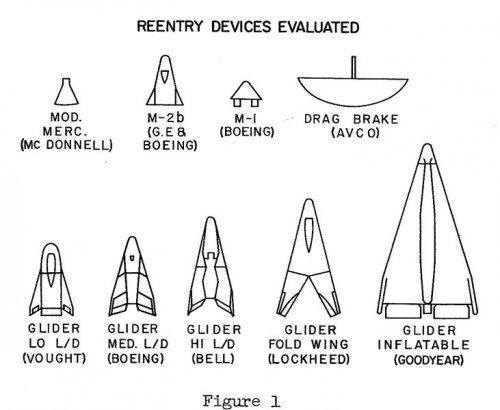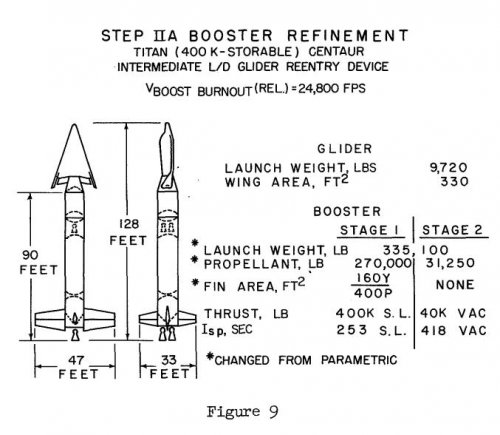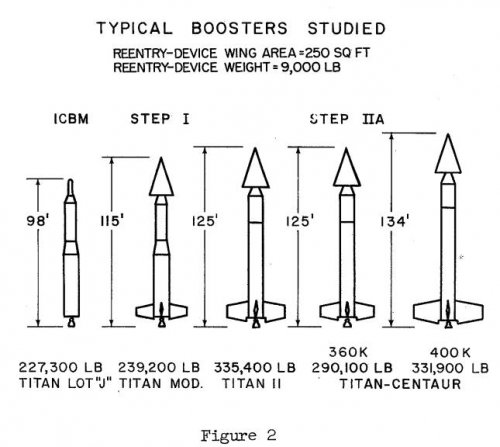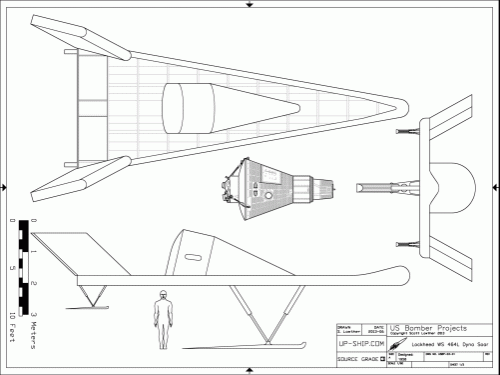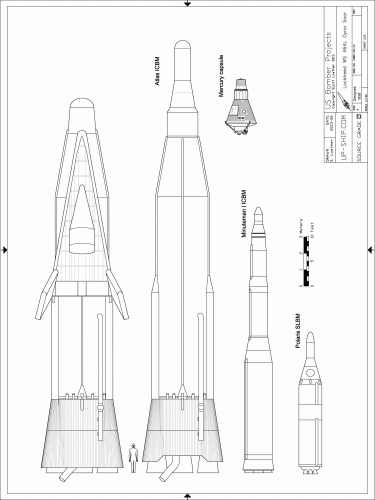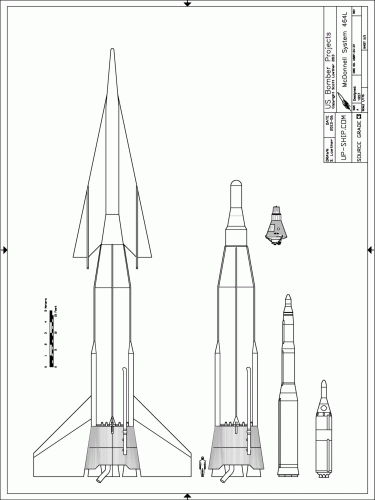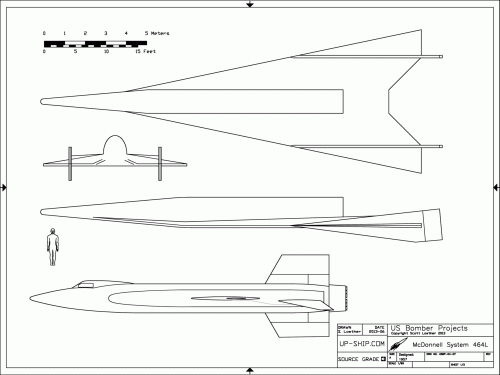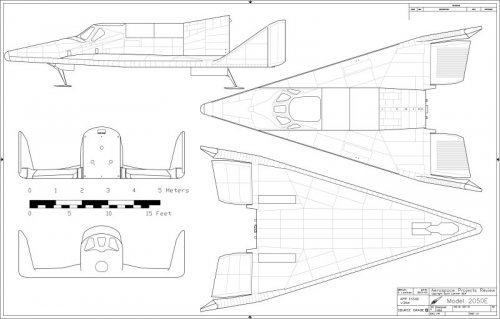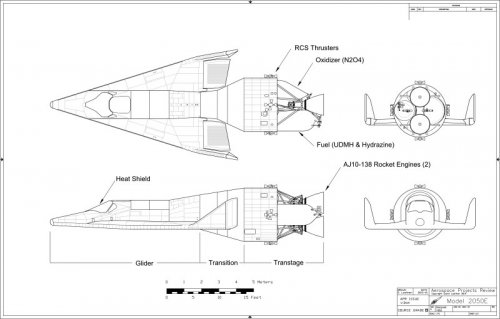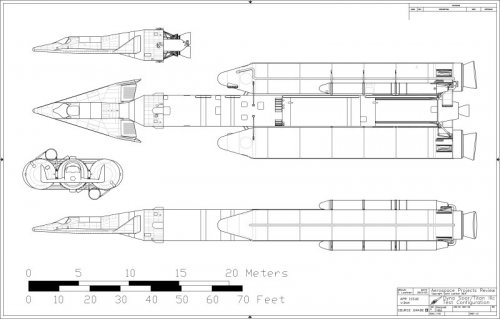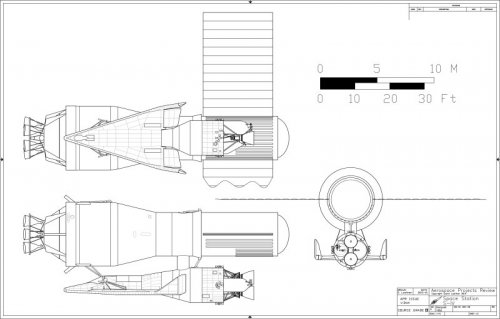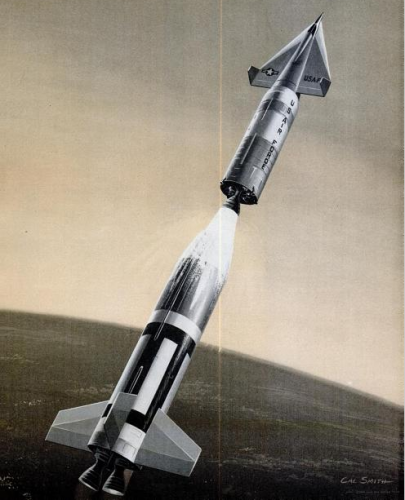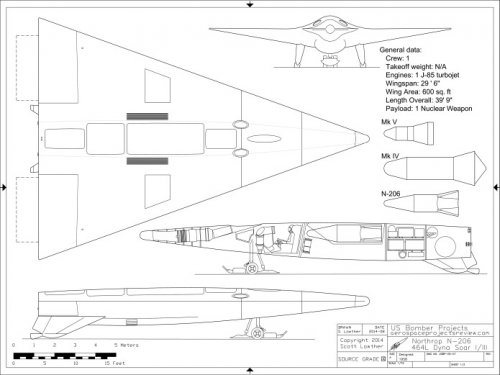You are using an out of date browser. It may not display this or other websites correctly.
You should upgrade or use an alternative browser.
You should upgrade or use an alternative browser.
Boeing X-20 Dyna-Soar and alternate projects
- Thread starter PMN1
- Start date
- Joined
- 13 August 2007
- Messages
- 8,445
- Reaction score
- 10,998
Me with surprise result !samardza said:has anyone other than me compared the dimensions of the X-37B and the X-20, including the cross section and payload bay dimensions?
what ever X-20, ALSV and X-37B had to carry, it has similar size:
X-20, Equipment compartment: 1.20 m x 1.89 m (assumption after technical drawing on X-20)
ALSV, Payload bay size: 1.52 m x 2.74 m
X-37B, payload bay size: 1.2 m x 2.1 m
- Joined
- 26 September 2008
- Messages
- 1,960
- Reaction score
- 746
Michel Van said:Me with surprise result !samardza said:has anyone other than me compared the dimensions of the X-37B and the X-20, including the cross section and payload bay dimensions?
what ever X-20, ALSV and X-37B had to carry, it has similar size:
X-20, Equipment compartment: 1.20 m x 1.89 m (assumption after technical drawing on X-20)
ALSV, Payload bay size: 1.52 m x 2.74 m
X-37B, payload bay size: 1.2 m x 2.1 m
I think you are jumping to conclusions. There is no payload that would have stayed the same size in 1960, 1980 and 2010.
blackstar said:There is no payload that would have stayed the same size in 1960, 1980 and 2010.
Passengers.
Not saying that the X-37 is going to be a taxi, just pointing out that people are more or less the same size.
- Joined
- 13 August 2007
- Messages
- 8,445
- Reaction score
- 10,998
oh yes Passengers do not downsize over 5 decades 
also not Optical equipment like Cameras, because the focal length of the lens.
or Antennas for Radar scanner.
also not Optical equipment like Cameras, because the focal length of the lens.
or Antennas for Radar scanner.
- Joined
- 26 May 2006
- Messages
- 34,894
- Reaction score
- 15,759
XP67_Moonbat said:http://ntrs.nasa.gov/archive/nasa/casi.ntrs.nasa.gov/19720063130_1972063130.pdf
U.S. AIR FORCE -
NATIONAL AERONAUTICS
AND SPACE ADMINISTRATION
JOINT CONFERENCE
ON
LIFTING MANNED HYPERVELOCITY
AND REENTRY VEHICLES
A COMPILATION OF THE PAPERS PRESENTED
PART II
April 13-1 4,1960
Guys this is 394 pages long. So it will take a bit to open. Enjoy.
Moonbat
http://ntrs.nasa.gov/archive/nasa/casi.ntrs.nasa.gov/19720063130_1972063130.pdf
From the same source.
Attachments
- Joined
- 26 May 2006
- Messages
- 34,894
- Reaction score
- 15,759
archipeppe
ACCESS: Top Secret
- Joined
- 18 October 2007
- Messages
- 2,431
- Reaction score
- 3,152
Great find Hesham!!!!
Thanks for it....
Thanks for it....
- Joined
- 13 August 2007
- Messages
- 8,445
- Reaction score
- 10,998
Titan-i with Centaur ?!
what for a Surprise, extent find Hesham !
what for a Surprise, extent find Hesham !
Interesting paper on "PRELIMINARY PERFORMANCE APJALYSIS OF AIR LAUNCHING
MANNED ORBITAL VEHICLES*"
http://ntrs.nasa.gov/archive/nasa/casi.ntrs.nasa.gov/19720063744_1972063744.pdf
AKA: How to launch a Dynasoar and booster
Randy
MANNED ORBITAL VEHICLES*"
http://ntrs.nasa.gov/archive/nasa/casi.ntrs.nasa.gov/19720063744_1972063744.pdf
AKA: How to launch a Dynasoar and booster
Randy
Hi All!
Boeing Model 814
Convair Model ?
Douglas Model 1???
Lockheed Model CL-4?? (or CL-3??)
Martin/Bell Model 3??/Bell Model D-1?? or D-2??
McDonnell Model 132A-C
North American X-15B (Model ?)
Northrop Model 1?? or Model 2??
Republic Model AP-9? (or AP-8?)
If you can write about Dyna Soar/X-20?
Boeing Model 814
Convair Model ?
Douglas Model 1???
Lockheed Model CL-4?? (or CL-3??)
Martin/Bell Model 3??/Bell Model D-1?? or D-2??
McDonnell Model 132A-C
North American X-15B (Model ?)
Northrop Model 1?? or Model 2??
Republic Model AP-9? (or AP-8?)
If you can write about Dyna Soar/X-20?
- Joined
- 26 September 2008
- Messages
- 1,960
- Reaction score
- 746
carmelo said:Was the X-20 Dyna Soar a reusable spaceplane?
Or every mission would have a brand new X-20?
And if reusable,how many could perform?
The plan was for it to be reusable.
But keep in mind that the "X" meant that it was experimental, so they did not know how well it would perform and how many times they could fly it. Also, it would only be flown as many times as they needed to collect the data.
One of the problems with the X-20--and really the thing that led to its cancellation--was that it was not a clearly focused program. It was called an experimental X-plane program, but the Air Force really wanted it to fly operational missions. It was too expensive for an X-plane, and it was too unproven to do operational missions. So it got canceled.
McDonnell's System 464L submission from 1958. Data is very lean on this; how, if the Lockheed design wasn't capable of attaining orbit, the McDonnell design would've, I've no idea unless it had a substantial on-board propulsion system.
Source
Source
Attachments
OM
ACCESS: Top Secret
Orionblamblam said:McDonnell's System 464L submission from 1958. Data is very lean on this; how, if the Lockheed design wasn't capable of attaining orbit, the McDonnell design would've, I've no idea unless it had a substantial on-board propulsion system.
...If the two diagrams are from the same proposal set, I suggest that the Atlas Adapter also contains the engine(s), which get(s) jettisoned once the fuel in the onboard tanks are exhausted. IIRC there were a couple of post-Columbia Shuttle replacements proposed that called for the SSMEs to be tossed, and at least one similar Buran pitch was talked about on .shuttle some years ago as well.
...That being said, that first image you posted sports an awfully thin wing area. In fact, I'm more apt to call it a "flying spade" more than some actually referred to the X-20 as being. I'd love to see if any actual wind tunnel tests were done with scale models of this design, not to mention the data.
:OM:
- Joined
- 13 August 2007
- Messages
- 8,445
- Reaction score
- 10,998
You Tube is your friend
take 15 minute and feast you eyes on this
http://www.youtube.com/watch?v=OYFhUO4tnSI
X-20 Dyna-Soar Development: "Springboard to Space: The Arnold Center Story" 1965 USAF
http://www.youtube.com/watch?v=JtFreN6iWnQ
The Story of Dyna-Soar - United States Air Force (loud intro!!!)
Test of Spacesuit on X-20 Part one
http://www.youtube.com/watch?v=B7mRXblByxo
Test of Spacesuit on X-20 Part two
http://www.youtube.com/watch?v=TikodTMGdP0
NASA Langley Research Center film # L-591 on Dyna Soar
http://www.youtube.com/watch?v=irLVpQPriVU
http://www.youtube.com/watch?v=Fx8HPESg6Hw
NASA Langley film # L-742 Landing Characteristics of a Winged Reentry Vehicle
take 15 minute and feast you eyes on this
http://www.youtube.com/watch?v=OYFhUO4tnSI
X-20 Dyna-Soar Development: "Springboard to Space: The Arnold Center Story" 1965 USAF
http://www.youtube.com/watch?v=JtFreN6iWnQ
The Story of Dyna-Soar - United States Air Force (loud intro!!!)
Test of Spacesuit on X-20 Part one
http://www.youtube.com/watch?v=B7mRXblByxo
Test of Spacesuit on X-20 Part two
http://www.youtube.com/watch?v=TikodTMGdP0
NASA Langley Research Center film # L-591 on Dyna Soar
http://www.youtube.com/watch?v=irLVpQPriVU
http://www.youtube.com/watch?v=Fx8HPESg6Hw
NASA Langley film # L-742 Landing Characteristics of a Winged Reentry Vehicle
Ahem:
93 pages of Dyna Soar.
93 pages of Dyna Soar.
- Joined
- 13 August 2007
- Messages
- 8,445
- Reaction score
- 10,998
Orionblamblam said:
a must read 93 pages, for those who got big Dyna Soar book from Apogee Books
get Aerospace Project Review V3N4 to get complete overview on Dyna Soar project.
Attachments
antigravite
ACCESS: Top Secret
- Joined
- 25 April 2008
- Messages
- 836
- Reaction score
- 258
Enjoy this scanned article just found by accident.
This source material has not been posted here yet. AFAIK, none of this material is posted on this forum, and I don't know to which extend we can.
David STERN, "Martin Bell's Alternate 1958 DynaSoar I studies revealed", QUEST, 15:1, 2008, pp.22-32
http://thehuwaldtfamily.org/jtrl/vehicle_data/X-Vehicles/X-20/Martin-Bell's%20Alternate%201958%20Dyna-Soar%20Studies,%20Quest%20V15N1,%202008.pdf
This material is available from a family-owned website operated by Joe who described this material as follows:"Welcome to my personal collection of technical reports. Most of the reports in this archive are related to my 20 some years as an aerospace engineer. However there are also reports and historical documents covering a broad array of scientific, engineering, mathematical, computer graphics, and computer programming subjects. All of the material in this archive should be public domain (most of it was created by United States Government agencies such as NASA) and I have filtered out any material from my private collection that is restricted by U.S. export laws."
source : http://thehuwaldtfamily.org/jtrl/
A.
This source material has not been posted here yet. AFAIK, none of this material is posted on this forum, and I don't know to which extend we can.
David STERN, "Martin Bell's Alternate 1958 DynaSoar I studies revealed", QUEST, 15:1, 2008, pp.22-32
http://thehuwaldtfamily.org/jtrl/vehicle_data/X-Vehicles/X-20/Martin-Bell's%20Alternate%201958%20Dyna-Soar%20Studies,%20Quest%20V15N1,%202008.pdf
This material is available from a family-owned website operated by Joe who described this material as follows:"Welcome to my personal collection of technical reports. Most of the reports in this archive are related to my 20 some years as an aerospace engineer. However there are also reports and historical documents covering a broad array of scientific, engineering, mathematical, computer graphics, and computer programming subjects. All of the material in this archive should be public domain (most of it was created by United States Government agencies such as NASA) and I have filtered out any material from my private collection that is restricted by U.S. export laws."
source : http://thehuwaldtfamily.org/jtrl/
A.
OM
ACCESS: Top Secret
Orionblamblam said:[...] how, if the Lockheed design wasn't capable of attaining orbit, the McDonnell design would've, I've no idea unless it had a substantial on-board propulsion system.
...There had to be *something* in mind. Lookit how it damned near dwarfs the Atlas just sitting on top of it. Hell, I've always felt that Dynasoar was sahotage from inside the Pentagon, as they didn't wan anyone working with propulsion technologies that could fit the bill, but the Soviets could easily get ahold of. Not a CT Nutter Mutter from this end, just a "gut feeling". And I"m on my stomach meds, thank you very much
:OM:
- Joined
- 26 May 2006
- Messages
- 34,894
- Reaction score
- 15,759
Attachments
CNH said:"What killed Dyna-Soar, ultimately?"
Robert McNamara.
- Joined
- 26 September 2008
- Messages
- 1,960
- Reaction score
- 746
carmelo said:CNH said:"What killed Dyna-Soar, ultimately?"
Robert McNamara.
It was going to go away on its own no matter what. The Air Force was spending a lot of money on something that had no realistic operational requirement and was too expensive to be merely experimental. The Air Force would have killed it anyway once Vietnam began ramping-up.
The Northrop N-206 spaceplane, entered into the System 464L competition for the Dyna Soar I/II/III role, 1958. More info in US Bomber Projects issue #9.
Attachments
- Joined
- 26 May 2006
- Messages
- 34,894
- Reaction score
- 15,759
Orionblamblam said:The Northrop N-206 spaceplane, entered into the System 464L competition for the Dyna Soar I/II/III role, 1958. More info in US Bomber Projects issue #9.
Excellent my dear Scott,and great find.
- Joined
- 1 November 2009
- Messages
- 638
- Reaction score
- 428
blackstar said:carmelo said:CNH said:"What killed Dyna-Soar, ultimately?"
Robert McNamara.
It was going to go away on its own no matter what. The Air Force was spending a lot of money on something that had no realistic operational requirement and was too expensive to be merely experimental. The Air Force would have killed it anyway once Vietnam began ramping-up.
Two down and one to go. The third factor in the death of Dynasoar was Kennedy's Man on the Moon speech and the way the country got behind that effort after he was killed. There was no way that the country was going to support two major space efforts at one time.
- Joined
- 3 June 2006
- Messages
- 3,094
- Reaction score
- 3,961
Quite a few Dyna Soar images at Boeing Images website.
Link:
http://www.boeingimages.com/C.aspx?VP3=SearchResult&VBID=2JRSN2PXV9SR&SMLS=1&RW=1920&RH=950
Link:
http://www.boeingimages.com/C.aspx?VP3=SearchResult&VBID=2JRSN2PXV9SR&SMLS=1&RW=1920&RH=950
- Joined
- 26 September 2008
- Messages
- 1,960
- Reaction score
- 746
The Artist said:blackstar said:carmelo said:CNH said:"What killed Dyna-Soar, ultimately?"
Robert McNamara.
It was going to go away on its own no matter what. The Air Force was spending a lot of money on something that had no realistic operational requirement and was too expensive to be merely experimental. The Air Force would have killed it anyway once Vietnam began ramping-up.
Two down and one to go. The third factor in the death of Dynasoar was Kennedy's Man on the Moon speech and the way the country got behind that effort after he was killed. There was no way that the country was going to support two major space efforts at one time.
I dunno. Remember that they created MOL around the same time. MOL was more focused on an operational mission, and it ultimately became rather expensive.
If you step back from the gee-whiz fanboy view of this period and look at it more objectively, it becomes clear that the Air Force was funding a bunch of big expensive programs that it could not really afford and that did not have clear missions. The B-70 and Dyna-Soar were probably the two best examples. McNamara killed them for good reasons, because they were eating a lot of money and they were not going to achieve any goals that the country really needed. If you look at some other advanced USAF programs of the mid-late 1950s you can see that the Air Force spent a lot of money on projects that didn't last very long. Atlas and Titan I, for instance, had short service lives. Thor also didn't operate for very long. So the Air Force was burning a lot of cash and had to be reigned in, which is what McNamara did.
blackstar said:Atlas and Titan I, for instance, had short service lives. Thor also didn't operate for very long.
I'm not sure that I agree with you 100% on your police work there, Lou. The Atlas and Thor are still flying *today.* The Titan line only died out in 2005. Fifty+ years seems like a pretty good run to me.
Had B-70 been allowed to continue, economical SST's *may* have resulted. Had Dyna Soar been allowed to continue, the Shuttle almost absolutely certainly would have been a vastly different program, based not only on Dyna Soar design work but also actual experience with maintenance and operations, and, with luck, ocean recovery of the SRB cases (which UTC examined and proposed). Dyna Soar would have either convinced NASA that the as-built-Shuttle was too hard, or it would have been redesigned to simplify things.
blackstar said:The Artist said:blackstar said:carmelo said:CNH said:"What killed Dyna-Soar, ultimately?"
Robert McNamara.
It was going to go away on its own no matter what. The Air Force was spending a lot of money on something that had no realistic operational requirement and was too expensive to be merely experimental. The Air Force would have killed it anyway once Vietnam began ramping-up.
Two down and one to go. The third factor in the death of Dynasoar was Kennedy's Man on the Moon speech and the way the country got behind that effort after he was killed. There was no way that the country was going to support two major space efforts at one time.
I dunno. Remember that they created MOL around the same time. MOL was more focused on an operational mission, and it ultimately became rather expensive.
If you step back from the gee-whiz fanboy view of this period and look at it more objectively, it becomes clear that the Air Force was funding a bunch of big expensive programs that it could not really afford and that did not have clear missions. The B-70 and Dyna-Soar were probably the two best examples. McNamara killed them for good reasons, because they were eating a lot of money and they were not going to achieve any goals that the country really needed. If you look at some other advanced USAF programs of the mid-late 1950s you can see that the Air Force spent a lot of money on projects that didn't last very long. Atlas and Titan I, for instance, had short service lives. Thor also didn't operate for very long. So the Air Force was burning a lot of cash and had to be reigned in, which is what McNamara did.
Ironically the senseless,detrimental and harmful war in Vietnam burned a lot of milions, invested in a catastrophic defeat.
At least the Dyna Soar would have been a investiment in a research vehicle for a future space plane.
Orionblamblam said:blackstar said:Atlas and Titan I, for instance, had short service lives. Thor also didn't operate for very long.
I'm not sure that I agree with you 100% on your police work there, Lou. The Atlas and Thor are still flying *today.* The Titan line only died out in 2005. Fifty+ years seems like a pretty good run to me.
.
Blackstar is right. He was referring to the ICBM's. The launch vehicle versions are not the same as the weapon systems. Comparing the vehicles today to Atlas and Thor of yesteryear is like comparing the 787 to B-29's.
Orionblamblam said:1. Had B-70 been allowed to continue, economical SST's *may* have resulted.
2. Had Dyna Soar been allowed to continue, the Shuttle almost absolutely certainly would have been a vastly different program, based not only on Dyna Soar design work but also actual experience with maintenance and operations, and, with luck, ocean recovery of the SRB cases (which UTC examined and proposed). Dyna Soar would have either convinced NASA that the as-built-Shuttle was too hard, or it would have been redesigned to simplify things.
1. Not really. The XB-70 contributed all it could to the SST in its research program. There would have been little to learn from the operational phase.
2. Nor really. The issue wasn't that they didn't know enough to design the shuttle for routine O&M, it was that NASA didn't have the money to do it right (much like being forced to go to SRM's vs LRB's)
Similar threads
-
-
-
-
-
Original US space program without the moon goal.
- Started by carmelo
- Replies: 4

